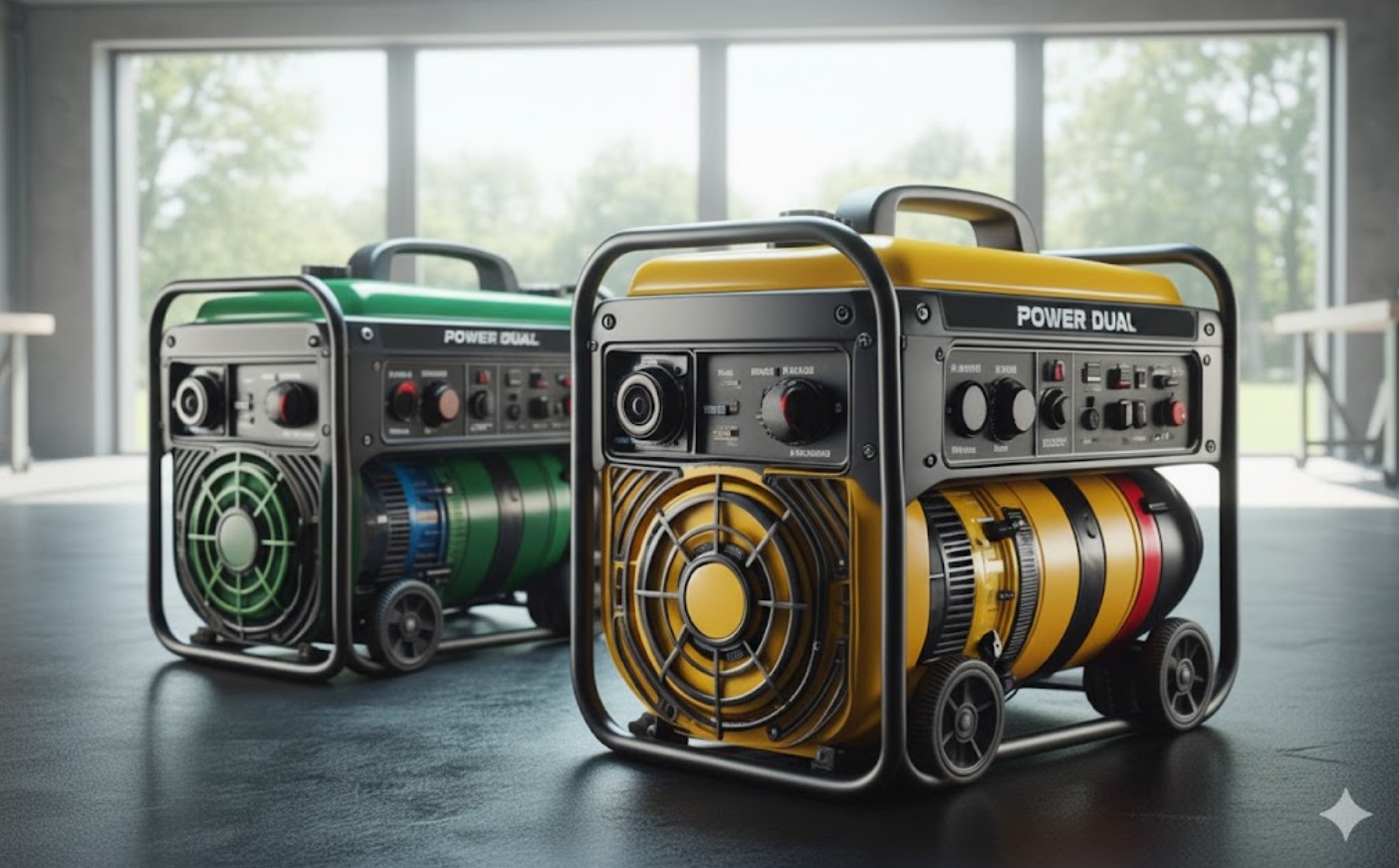 In the quest for reliable backup power, few decisions are as critical as choosing the right type of generator. As power outages become more frequent and unpredictable, homeowners and professionals alike are weighing their options. The market essentially boils down to two categories: the tried-and-true single fuel generator, typically running on gasoline, and the increasingly popular dual fuel generator, offering the flexibility of both gasoline and propane. This comprehensive guide dives deep into the technical, practical, and financial differences between Dual Fuel Generators Vs Single Fuel Generators, equipping you with the knowledge to make an informed, confident choice that guarantees power when you need it most.
In the quest for reliable backup power, few decisions are as critical as choosing the right type of generator. As power outages become more frequent and unpredictable, homeowners and professionals alike are weighing their options. The market essentially boils down to two categories: the tried-and-true single fuel generator, typically running on gasoline, and the increasingly popular dual fuel generator, offering the flexibility of both gasoline and propane. This comprehensive guide dives deep into the technical, practical, and financial differences between Dual Fuel Generators Vs Single Fuel Generators, equipping you with the knowledge to make an informed, confident choice that guarantees power when you need it most.
Understanding the Basics of Fuel Types and Engine Design
To properly compare these machines, we must first look beneath the hood—or, in this case, the chassis—at how they use fuel and what defines each type.
The Single Fuel Workhorse: Gasoline and Diesel
For decades, the standard portable generator has been a single fuel unit, relying heavily on gasoline. These generators are powerful, easily acquired, and generally operate at their maximum-rated capacity on the primary fuel source. However, their reliance on a single fuel type creates a significant logistical vulnerability, especially during widespread emergencies when gasoline stations are either closed or quickly run dry.
- Gasoline Pros: High energy density (more power per gallon), excellent performance, and easy ignition.
- Gasoline Cons: Extremely poor shelf life (degrades quickly, requiring stabilizers), highly volatile and hazardous to store, and nearly impossible to acquire during mass power outages.
- Diesel (for larger units): Excellent efficiency and safety (low volatility), but diesel generators are typically larger, more expensive, and produce more noise.
The Achilles’ heel of the single fuel gasoline generator warrants deeper discussion: the chemistry of gasoline degradation. Gasoline is a complex blend of hydrocarbons, additives, and ethanol (in most regions). Over time, and accelerated by heat and moisture, the lighter hydrocarbons evaporate, leaving behind heavier, less volatile components. Crucially, the ethanol content attracts water, leading to phase separation where the water and ethanol sink to the bottom of the fuel tank, causing corrosion and leaving a gummy residue that clogs filters, lines, and the carburetor jets. This process is so rapid that even a partial tank of unstabilized fuel can make a generator difficult or impossible to start after a few months of storage. Consequently, the user of a gasoline-only generator must commit to either adding fuel stabilizer every time or running the carburetor dry after every use, and continually rotating their stored fuel supply. This level of mandatory, proactive maintenance introduces a high point of potential failure during a high-stress emergency.
Furthermore, the reliance on gasoline means that the user is entirely subject to the immediate availability of the transportation network. In the wake of a large-scale disaster like a hurricane, the single fuel generator may become completely useless within 48-72 hours simply because the fuel supply has been exhausted, contaminated, or is geographically inaccessible. This fragility is the primary reason why preparedness experts increasingly favor fuel flexibility.
In contrast, the modern power backup strategy prioritizes resource redundancy, which is where the dual fuel option enters the arena.
The Dual Fuel Advantage: Gasoline and Propane
A dual fuel generator is engineered to operate on two distinct fuel sources: gasoline and liquid propane (LP) gas. These generators come equipped with a specialized carburetor or fuel selection system that allows the user to seamlessly switch between fuels, a flexibility that is invaluable in crisis scenarios. Propane is stored in easily sourced, portable tanks, offering a reliable alternative when gas pumps are inaccessible or empty. Therefore, the dual fuel design significantly enhances operational security and extends run time capabilities.
If you’re interested in checking out top-rated models, a quick look at the best dual fuel generators will show you the range of power and features currently available in the market.
Head-to-Head Comparison: Fuel Flexibility and Logistical Advantages
The core difference between Dual Fuel Generators Vs Single Fuel Generators lies in the availability, storage, and handling of their respective fuels.
Fuel Shelf Life and Long-Term Storage
This is arguably the most compelling argument for choosing dual fuel. Gasoline is notorious for its short shelf life. Unstabilized gasoline can begin to degrade in as little as 30 days, gumming up the carburetor and fuel lines—a primary cause of generator failure during emergencies. While stabilizers can extend this life, they are not a permanent solution, demanding that users constantly cycle their fuel supply.
Propane, however, does not degrade. It can be stored indefinitely in approved tanks (which are subject to periodic recertification). This means a reserve of propane tanks offers instant, reliable fuel availability years down the line, without the maintenance headache associated with stored gasoline. Consequently, the dual fuel option drastically reduces the stress and labor of pre-outage preparation.
The comparative advantage of propane storage for dual fuel generators cannot be overstated, especially from a preparedness perspective. The indefinite storage life is due to propane’s nature as a stable, simple hydrocarbon compound (C3H8) stored in a pressurized liquid state. It does not suffer from the chemical decomposition or water absorption issues that plague gasoline. Indeed, a properly stored and maintained propane tank is ready to deliver fuel decades after being filled, making it the ideal choice for a backup supply that may sit unused for years.
There are, however, regulatory aspects to propane storage that must be considered. Propane tanks must be stored outdoors, away from ignition sources, and not near building entry points. Furthermore, they are subject to Department of Transportation (DOT) or American Society of Mechanical Engineers (ASME) regulations, which require periodic hydrostatic testing (usually every 10-12 years for DOT tanks) to ensure their integrity. Yet, these minor regulatory hurdles are a small price to pay for the massive logistical advantage of safe, long-term, ready-to-use fuel. Economically, the ability to buy propane in bulk (such as contracting for a 100-gallon tank fill during the off-season) allows the owner of a dual fuel generator to lock in lower prices and ensure a guaranteed fuel quantity, insulating them from crisis-driven price hikes, a benefit a single-fuel gasoline user simply cannot realize.
Acquisition During a Crisis
During a major storm or disaster, the first resources to disappear are gasoline and cash. Fuel lines snake around gas stations, which may themselves lose power, rendering the pumps useless. Conversely, propane is often less constrained. While propane tanks may also sell out, they are distributed through different supply chains (hardware stores, big box stores, specific propane dealers) and can be delivered in large quantities (like a 100lb tank) that offer days of run time. Furthermore, many homes already have large propane tanks for heating or cooking, offering an immediate fuel source for a dual fuel generator.
Safety and Handling
Propane is a much safer fuel to store and handle than gasoline. Propane tanks are robust and designed to prevent spills. While propane leaks are highly flammable, liquid propane itself is less volatile than gasoline, which can easily ignite from heat or a spark. Storing multiple gallons of volatile gasoline in an attached garage or shed is a significant fire risk. In summary, the logistical safety and indefinite storage life of propane give the dual fuel option a distinct, undeniable advantage in emergency preparedness.
Technical Performance: Power Output and Fuel Efficiency
While flexibility is important, performance is non-negotiable. Understanding how each fuel impacts a generator’s power output and efficiency is essential for choosing a unit that meets your power needs.
Wattage Derating on Propane
A fundamental technical reality of dual fuel generators is wattage derating. A generator running on propane will consistently produce less power than when running on gasoline. The energy density of propane is lower than that of gasoline; therefore, the engine cannot achieve the same power output. The reduction typically ranges from 10% to 20% of the unit’s maximum gasoline rating.
To elaborate on the technical reason for wattage derating, we must consider the British Thermal Unit (BTU) content and the intake manifold design. A BTU is the standard measure of energy content in fuel. Gasoline typically has a BTU content of around 125,000 BTUs per gallon, while propane has a much lower volumetric energy content, about 91,500 BTUs per gallon (as a liquid). When running on propane, the fuel is introduced into the engine as a gas, which displaces some of the air required for combustion, further lowering the engine’s volumetric efficiency. Consequently, to avoid overly rich or lean mixtures and to maintain engine longevity, the generator’s fuel system is calibrated to accept the reduced energy input from propane, resulting in the predictable 10-20% drop in power output.
This difference is critical. If you purchase a 7,000-watt running power dual fuel generator, expect only 5,600 to 6,300 running watts on propane. Thus, when sizing a dual fuel generator, you must base your calculations on the propane output to ensure you can still power all essential loads during a long-term outage where only propane is available. To calculate your specific power needs, resources like a load calculator are highly recommended.
Fuel Consumption and Run Time
Single fuel gasoline generators offer the best efficiency when measured by run time per gallon of fuel, simply due to the fuel’s higher energy density. Conversely, propane burns slower and cleaner, but because of the lower energy density, the unit will consume more cubic feet of propane to generate the same electrical load compared to the volume of gasoline. However, the sheer size advantage of propane storage often compensates for this.
For example, a standard 20-pound propane tank can offer anywhere from 6 to 10 hours of run time at a 50% load. Since propane can be stored in tanks ranging from 20 lbs to 100 lbs or more, the potential for extended, uninterrupted run time is far greater with a dual fuel setup than with storing an equivalent amount of easily degrading and volatile gasoline.
The Cost Dynamics and Maintenance Requirements
Beyond performance, the long-term cost of ownership, including initial price, fuel expenses, and maintenance labor, is a major factor in the choice between Dual Fuel Generators Vs Single Fuel Generators.
Initial Purchase Price
Generally, a dual fuel generator will have a higher upfront cost than a comparable single fuel gasoline generator. This difference is due to the more complex engine components, including the specialized carburetor or fuel system regulator, and the necessary lines for connecting the propane tank. Nevertheless, this slightly higher initial investment is often viewed as a worthwhile premium for the added flexibility and peace of mind.
Fuel Cost Fluctuation
Fuel costs vary drastically by region and season. Historically, propane (per BTU/energy output) can be slightly more expensive than gasoline, but this is offset by the ability to shop around and buy in bulk. Crucially, during a disaster, the price of gasoline can spike or be irrelevant if it is simply unavailable. The dual fuel unit allows the user to choose the cheapest or most readily available fuel at any given moment, offering a hedge against supply chain disruptions and price gouging.
Engine Longevity and Maintenance
Propane burns much cleaner than gasoline. It leaves fewer carbon deposits and residues inside the engine components, especially the carburetor. Therefore, a dual fuel generator that sees frequent use on propane will often have a cleaner engine, requiring less carburetor maintenance and potentially offering a longer overall lifespan than a generator running exclusively on stale gasoline. Propane is also far less likely to cause hard-starting issues, a common complaint with gasoline-only units that have sat idle for a few months. On the other hand, if the dual fuel unit is primarily run on gasoline, the maintenance requirements revert back to the high-maintenance demands of the single fuel gasoline unit.
The superior cleanliness of propane combustion directly translates to less maintenance complexity. In single fuel gasoline generators, the carburetor is the most common failure point after extended storage. The small, precisely drilled jets within the carburetor are easily blocked by the varnish and sediment left behind as gasoline evaporates. Cleaning or replacing a clogged carburetor is a tedious, often expensive task that requires mechanical proficiency. Furthermore, the high volatility of gasoline means the fuel lines are constantly pressurized with fumes, which can degrade rubber components over time.
Propane eliminates this problem entirely because it is introduced as a vapor through a specialized regulator and does not leave a residue in the fuel lines or carburetor when shut off. When a dual fuel generator is run on propane, the gasoline side of the system is effectively bypassed, protecting it from the degradation issues of stored liquid fuel. This protection alone makes the dual fuel generator a more reliable choice for users who anticipate long periods between usage. The simple action of running the unit exclusively on propane for its monthly exercise is often all the maintenance needed to ensure the gasoline line remains dry and clean, ready to be used if necessary.
Regardless of the fuel type, proper maintenance is key. If you own a dual fuel generator, you must know how to switch between fuels in dual fuel generators safely and effectively to utilize your generator’s full potential.
Safety Considerations and Environmental Impact
Safety is the primary concern for any power solution. The choice between Dual Fuel Generators Vs Single Fuel Generators also has implications for home safety and environmental footprint.
Carbon Monoxide and Combustion
It is absolutely critical to state that all combustion engine generators, regardless of fuel type, produce lethal amounts of carbon monoxide (CO). They must ALWAYS be operated outdoors, far away from any windows, doors, or vents. Nevertheless, propane burns much cleaner than gasoline. This results in slightly fewer harmful emissions (though still high enough to be lethal indoors), making the propane operation marginally better for the local environment and potentially less prone to sensor-fouling issues compared to the dirtier gasoline exhaust.
Fuel Spill and Fire Risk
As discussed, the fire risk associated with liquid gasoline storage is high. Propane tanks, while pressurized, are designed with stringent safety standards. A dual fuel generator eliminates the need to constantly refuel a hot engine with a volatile liquid, as propane tanks can simply be swapped out after the generator has been shut off. Thus, the dual fuel option provides a clear safety advantage by minimizing the presence and handling of highly flammable, volatile liquid fuel.
The Three-Fuel Option: Natural Gas
For those considering a more permanent solution, many large whole house generators are tri-fuel capable, adding natural gas (NG) to the mix. Natural gas is the ultimate fuel source for home backup, as it is piped directly to the home, offering an almost infinite run time and eliminating the need for any on-site fuel storage. While this moves the comparison out of the portable Dual Fuel Generators Vs Single Fuel Generators scope, it is the ultimate expression of fuel redundancy for residential power. If you are exploring permanent solutions, you should investigate whole house generators.
Real-World Scenarios and Best Applications
The practical choice depends entirely on the generator’s intended use and the user’s specific risk tolerance.
Portable Job Site Use (Single Fuel Preference)
On a construction site, maximum power output and the convenience of a widely available fuel are often paramount. Construction crews can easily refuel from local gas stations or on-site fuel storage units, and the high-density power of gasoline is often required to run heavy-duty tools that need peak starting watts. For this reason, single fuel gasoline generators remain a top choice for commercial, short-duration, high-demand portable use.
Extended Residential Backup (Dual Fuel Preference)
For home backup—especially in regions prone to multi-day or multi-week outages (like hurricane or ice storm zones)—fuel logistics dictate the decision. A dual fuel unit offers the necessary redundancy. The owner can use the initial tank of gasoline for the first 12-24 hours while assessing the crisis, then switch to the large, safe supply of stored propane for the duration of the outage. This ability to switch is not just convenient; it’s a lifeline. Therefore, the dual fuel generator is the undisputed champion for residential preparedness.
Fuel Switching Mechanics and Practicality
Operating a dual fuel generator means mastering the simple transition between fuel types. This process generally involves turning off the gas flow, allowing the engine to run until the line is empty (to prevent stale fuel from sitting in the carburetor), shutting the unit off, and then connecting the new fuel source (propane or gasoline line). Crucially, never switch fuels while the generator is under load. Always follow the manufacturer’s directions on how to switch between fuels in dual fuel generators to avoid damaging the unit or causing dangerous power fluctuations.
Final Analysis and Choosing Your Best Solution
The market comparison between Dual Fuel Generators Vs Single Fuel Generators ultimately comes down to a trade-off between peak power output and superior logistical flexibility.
The Case for Single Fuel (Gasoline)
Choose a single fuel gasoline unit if your primary concern is the lowest possible upfront cost, maximum power output (getting that extra 10-20% wattage), and you only need power for short, infrequent outages where gas stations are likely to remain operational. Nevertheless, be prepared to deal with fuel stabilization, short shelf life, and the inherent volatility of storing liquid gasoline.
The Case for Dual Fuel (Gasoline/Propane)
Choose a dual fuel generator if your priority is peace of mind, long-term preparedness, and fuel redundancy. The ability to run on indefinitely storable propane is a massive advantage for extended outages, making the unit significantly more reliable in a disaster. The slightly higher initial cost and the 10-20% reduction in power on propane are minor concessions for the massive gains in safety, storage life, and logistical flexibility. For this reason, dual fuel models are often highlighted as the best dual fuel generators for the modern homeowner.
Final Thoughts
In emergency preparedness, redundancy is everything. Having a Dual Fuel Generator means that if one fuel source fails—whether the gasoline is too old to burn or the local gas station is closed—you instantly have another, perfectly viable option ready to go. This dual capacity transforms the generator from a simple power tool into a truly robust survival asset. Ultimately, the flexibility and superior storage capabilities of propane-capable units make them the smarter long-term investment for residential and emergency power backup.
Amranul is a highly experienced product review writer with a passion for helping readers make smart, informed purchasing decisions. Since 2018, he has specialized in thoroughly researching and analyzing a wide range of products to deliver honest, in-depth reviews. Amranul combines technical accuracy with clear, engaging writing to break down complex product features and highlight true user value. Look for his reviews to find reliable information and expert insights you can trust before you buy!





